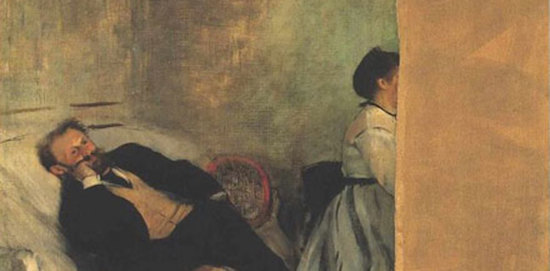History throws up some fabulously embittered feuds between great artists. Michelangelo, with his quick tongue and eviscerating put-downs, is one artist who appears to have been unable to live without them. Among those with whom he swore enmity were Raphael, who threatened to usurp him in Pope Leo X’s favours; Leonardo, an artist to surely equal his genius as perhaps no other could, and who must surely have felt Michelangelo’s wrath the most keenly as a result; and Titian, about whom he remarked that he might have been great, if only he’d been taught to draw.
And then we have the epic rivalry between two of the elder statesmen of 19th-century French painting, Delacroix and Ingres, the first the heady Romantic, the other the rigorous Classicist. The two Frenchmen not only detested one another personally, but their art embodied two opposing artistic strains, that of disegno, which promotes the exacting skill of drawing, and colorito, which emphasises the seductive appeal and expressive potential of pigment. Four centuries earlier, these two artistic camps had also underpinned the essential difference between Michelangelo and Titian.
Fast forward to the intimate rivalries explored by Sebastian Smee in his riveting book The Art of Rivalry, and we get a sense of how these two artistic cultures underpinned the radical evolution of artists who defined the avant-garde and pushed painting in startling new directions.
Divided into four compelling sections, Smee explores four separate friendships: between Edouard Manet and Edgar Degas; Henri Matisse and Pablo Picasso; Willem de Kooning and Jackson Pollock; and Lucian Freud and Francis Bacon. We encounter relationships that are complex, fraught and riven by tension – erupting all too often in the case of Freud and Bacon and de Kooning and Pollock, into drunken punch-ups in bohemian drinking dens.
But these friendships also offered a necessary buttress against hostile critics and a bourgeois public largely unsympathetic to the shock of the new. Many artists often did suffer for their art – at least in terms of the constant humiliation suffered at the hands of nonplussed critics and a jeering public. And it’s this antagonism towards the avant-garde, rather than any on-off hostility between the artists themselves, that goes some way to explaining why Smee decided to focus on artists working in the 19th and 20th centuries.
“I think that something different is happening in the modern era,” Smee explains. “It has to do with the fact that the old criteria of excellence in art is breaking down. Rather than mastering and extending a pre-existing tradition, artists at this time are trying to do something disruptive and original. So where are you going to get affirmation that what you’re doing is actually worth anything? The answer is that you get it from your fellow artists. And if there’s one particular artist that’s close to you and is inspired or influenced by you, then at least you can do a great deal to fortify your own sense of confidence – the sense that you are in fact on the right track.”
This was no small consolation, since the hostility encountered from those who were seen as the gatekeepers to critical as well as financial success could be astonishingly ferocious. It undoubtedly was in the case of Manet. Manet’s two great masterpieces Olympia and Le Déjeuner sur l’herbe were both rejected by the official salon, from whom he never stopped seeking recognition.
“We think of Manet as one of the first artists of modernism, if not the first,” Smee says, “but he really copped a beating in the 1860s. There were moments, especially around 1867 to 68, when he was in total despair. He produced very little at that time.”

Sebastian Smee © Pat Greenhouse
What critics found unpalatable about Manet, who, in contrast to the socially awkward Degas, cut an outwardly assured, charming and urbane figure, was his stark realism, his lack of subtle modelling from light to dark, so that his figures often appear flattened and crude, and the unfinished quality of his bravura brushwork.
But, clearly, it wasn’t just his technical radicalism that the academy rejected, but his shocking subject matter. Manet transposes classical subjects such as the nude, into a startlingly contemporary setting: a classical Venus suddenly becomes a modern-day Parisian prostitute – not yielding and pliant but self-possessed, even confrontational.
The section dealing with Manet and Degas’s friendship is the one that Smee says he enjoyed writing the most, and he places at the heart of the book’s introduction a compelling story of Degas’s double portrait of Manet and his wife Suzanne. Here we find Manet lounging on a sofa, his face conveying an expression that might be read as distracted boredom, as Suzanne, an accomplished pianist, plays the piano with her back to him.
Degas gave the painting to Manet, but, for whatever reason (Smee later speculates), Manet at some point decided to take a knife to it, cutting away at much of his wife’s profile. The usual reason given for such an ostensibly violent act was that Degas gave a less than flattering portrayal of her. Yet Smee suggests there is surely more to it: “You don’t take a knife to a painting quite so easily,” he says. After Manet’s death, Degas, filled with grief, and perhaps remorse at having offended his friend, tried to repaint Suzanne’s image, but he eventually leaves that side of the painting blank. And this is how we encounter the work, which is now in a Japanese museum, today.
The story of Degas’s portrait is one of countless incidents and anecdotes that make this book such a thrilling read. Here, not just individual biography but an understanding of the intimate relationships that were key in these artists’ lives, freshly illuminates the work.
As Smee wonderfully illustrates, the dynamic of each friendship was volatile and constantly shifting. Influences and inspirations were inevitably a two-way phenomenon. The artist positioned as the acolyte early on in the friendship benefitted from its liberating effects – it allowed him to be far bolder, freer, more daring, and not so technically constipated as he was before the encounter. Without, for instance, Picasso’s meeting with the older Matisse, who was much the bolder artist in those early years, would Picasso have even dared to go as far as he did when he painted his breakthrough 1907 proto-Cubist masterpiece Les Demoiselles d’Avignon?
Smee makes a convincing case that it’s his encounter with Matisse that spurs Picasso on to such heights. After all, rivalry is the engine of artistic innovation, and Picasso knows that at that point it is Matisse who is by far the more radical artist. Lest we forget, it is also Matisse who introduces Picasso to African sculpture as well as to the possibilities of children’s art (Matisse was especially taken with the drawings and paintings of his own children), both of which are a revelation to Picasso and fundamental to the story of modernism.
Matisse in turn draws lessons from Picasso’s Cubism, substituting voluptuous shapes for geometric ones. And it’s this constant see-sawing of influences that finds its echo in each of the other pairings, including de Kooning and Pollock’s, the most aggressively volatile of the friendships – as destructive on a personal level as it is inspiring on a creative one.
Smee, a Pulitzer Prize-winning critic with the Boston Globe, who has previously published five books on Lucian Freud, says the seeds of the The Art of Rivalry go back as far as 2002, when, 10 years after Bacon’s death, he first interviewed Freud.
Smee says he was struck by the big Western-style ‘wanted’ poster on the wall of Freud’s studio. It featured a reproduction of a portrait of Bacon that Freud had painted in 1951, and which was subsequently stolen from a museum in Berlin during a major touring retrospective. The wanted-style poster was an attempt to get the portrait back, with a reward of 300,000 Deutschmarks. The appeal didn’t succeed, but it was clear that both the painting and Bacon meant a great deal to Freud. “He was surprisingly open about what Bacon had meant to him and why they had fallen out,” Smee says. It was a complicated relationship to say the least, and Freud, who was 12 years Bacon’s junior and in his early 20s when they met, seemed somewhat emotionally out of his depth, often bewildered by Bacon’s apparent penchant for sadistic lovers.
A sense of loss haunts this book, but it’s not just the losses experienced when deep friendships flounder, or death intrudes. Underlying it is a sense of the loss of modernism’s heroic golden age, when artists strove for greatness, and where that greatness appeared meaningful and mythically loaded – however laden with strutting machismo that notion appears to us today. And we are of course talking about male artists, since patriarchy prevails and women were allowed only walk-on parts – if that – in this story of modernism. Still, this is a story in which art really did seem to shake the world.
The Art of Rivalry by Sebastian Smee is out now from Random House


